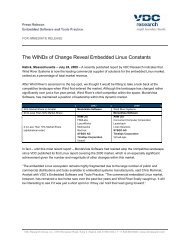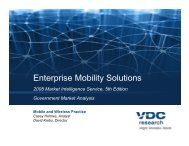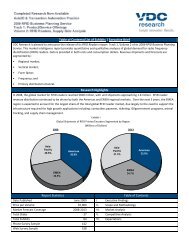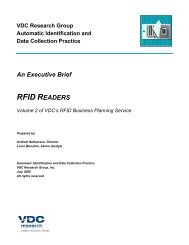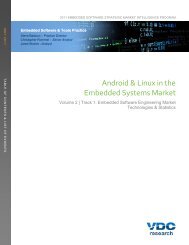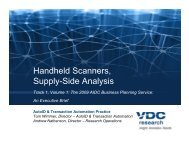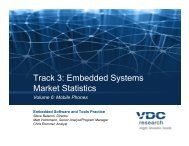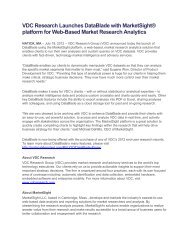Embedded/Real-Time Operating Systems - VDC Research
Embedded/Real-Time Operating Systems - VDC Research
Embedded/Real-Time Operating Systems - VDC Research
Create successful ePaper yourself
Turn your PDF publications into a flip-book with our unique Google optimized e-Paper software.
Strategic Issues, Trends & Market Drivers<br />
Roll-Your-Own (RYO) OS is the primary competition –internal OEM engineering<br />
organizations<br />
<strong>VDC</strong> has observed over the years that suppliers<br />
of commercial OSs will almost always cite rollyour-own<br />
OSs and OEM internal engineering<br />
organizations as their primary competition.<br />
“RYO is our primary competition. However, as<br />
software complexity continues to increase,<br />
companies are looking for reliable, fully tested<br />
and well-supported commercial platforms.”<br />
- <strong>Embedded</strong> OS supplier<br />
As the requirements for embedded systems have<br />
changed, OEMs face increasing levels of<br />
complexity from integrating new silicon<br />
architectures to the development and integration<br />
of in-house developed code, commercially<br />
available software components, and open source<br />
software. All of these issues present unique<br />
challenges to OEMs that demand a disciplined<br />
approach to developing, testing, and integrating<br />
software which represents the increasing<br />
importance of device software.<br />
“The advantages of an in-house OS is that it is<br />
usually well known and understood by the<br />
company using it. Free development tools can<br />
have the advantage of lower cost to application<br />
developers if the quality is adequate.”<br />
- <strong>Embedded</strong> OS supplier<br />
<strong>Embedded</strong> engineers responding to our surveys<br />
cite a gradual migration within their product<br />
development to increasing use of commercially<br />
available and supported OSs. RYO OS users are<br />
faced with the same market forces as the<br />
commercial user community in terms of increased<br />
product complexity in hardware and software,<br />
competitive time-to-market pressures, and the<br />
need to minimize inefficiencies across projects.<br />
The major roadblock in switching RYO OS users<br />
to commercial OS users continues to be cost,<br />
control, and inertia. Commercial OS vendors<br />
need to work closely as part of an education,<br />
relationship sell, to provide a compelling case to<br />
overcome these issues.<br />
“Engineering organizations need to look at their<br />
ongoing maintenance costs for supporting inhouse<br />
OS's/tools and see how that compares<br />
to the use of a commercial OS. The internal<br />
development cost to add new processor<br />
support, BSP support, SMP support, new<br />
features, and certification to an in-house OS<br />
can be prohibitive to the in-house developers.”<br />
- <strong>Embedded</strong> OS supplier<br />
As software complexity continues to increase,<br />
engineering organizations are looking for<br />
reliable, fully tested and well-supported<br />
commercial platforms that can enable product<br />
development to quickly adapt to key<br />
technology trends (i.e., multicore, virtualization,<br />
safety/security certification, etc.). Niche<br />
markets will continue to have a RYO need and<br />
it becomes a trade off as to when these niche<br />
markets become big enough for a commercial<br />
vendor to step in and fill the need. In working<br />
closely with RYO OS users, commercial OS<br />
vendors must gain their trust and give them<br />
reasons to change.<br />
OEMs, especially large companies who<br />
support multiple product lines, are increasingly<br />
using product line management techniques for<br />
software. In this case, companies are<br />
strategically architecting core assets for reuse<br />
across multiple products. A common OS, APIs,<br />
development tools, and middleware enable<br />
developers to focus on the application and<br />
enable the reuse of software code across<br />
different generations of products and product<br />
lines. OEMs will look to scale back the use of<br />
RYO OSs and consolidate on commercial OSs<br />
that offer broad functionality and scalability that<br />
can be used across a variety of products.<br />
vdcresearch.com<br />
© 2012 <strong>VDC</strong> <strong>Research</strong> Group, Inc.<br />
<strong>Embedded</strong> Software & Tools<br />
6



